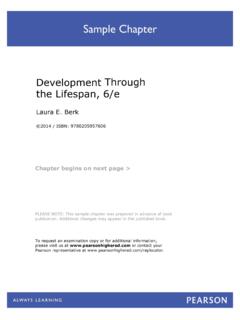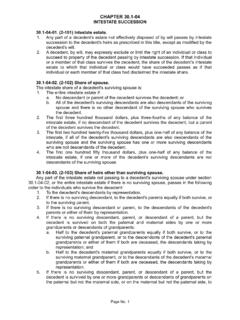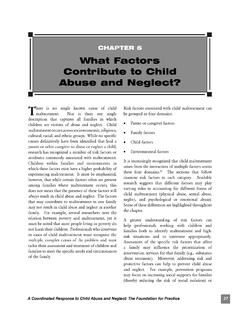Transcription of What Is a Relationship-Based Approach? - Pearson
1 PrefaceThis new edition of a comprehensive, applied text not only covers, but celebrates, infant and toddler development from prebirth through age 36 months, curriculum and program planning, and guidance using a Relationship-Based model. In addition, it focuses on the importance of families and teachers relationships and responsive-ness in interactions with children; the latest developmental research; an emphasis on child -centered planning; a particularly strong coverage of infants and toddlers with special needs; and an emphasis on the effects of culture, families, and quality programs on infant-toddler development and interactions. It is research based and written so that the information is accessible and highly motivating to a wide range of Is a Relationship-Based Approach? Infants and toddlers have emotional and social needs to feel safe, valued, loved, and appreciated for their individuality and to be deeply connected with their family, culture, important adults, and peers.
2 Supportive and positive rela-tionships meet these needs and create the environment in which development and Toddler Development and Responsive Program Planning uses a Relationship-Based model as a framework for understanding how infants and toddlers grow and learn with the support of their families and teachers. A rela- tionship -based model respects the effects of an individual child s characteristics and the child s environment on the quality of the child s relationships. These relationships then become the filter and the catalyst for children s sense of well-being and development. As you use the Relationship-Based model to discover the importance of the infant and toddler years, we hope that you will gain a sense of enthusiasm and excitement about the influence that infant and toddler professionals can have on the quality of experiences and programs for young children and their This Book Provides for Our ReadersOur text provides a foundation in how infants and toddlers develop, in typical and atypical ways, and in program and How of developmental practiceWe present all aspects of development within the context of brain development and the foundational structure of emotional development and early relation-ships.
3 We want students to understand why, according to the science of child development, certain practices support or hinder an infant s or toddler s optimal development and how to provide responsive, high-quality care. This book inte-grates theory, research, and practice in usable language for 528/02/13 8:01 PMvi Prefaceprogram planningIn addition to including developmental content, it also uniquely includes pro-gram planning, which highlights the following components: 1. developing the foundation of a program 2. the teacher s roles 3. the importance of relationships with families and how to provide culturally sensitive care 4. a responsive planning process 5. conducting sensitive transitions and routines 6. creating responsive and Relationship-Based environments 7. providing responsive experiences and opportunities for children 8.
4 A Relationship-Based approach to guidanceAn Emphasis on Culture and Children with DisabilitiesTo fully respect the impact of culture on early development, information on this and on the importance of inclusion of children with disabilities in early education and development programs is included throughout the book. These topics are presented as they relate to the major content of each chapter, such as how disabil-ities may affect learning or how people from different cultures approach learning. Many of the scenarios in italic type are about children who develop atypically as well as on a more typical to This Edition 1. Video links have been embedded in this new edition s Pearson eText. Several videos relevant to the chapter content have been embedded in each chapter of this edition s Pearson eText. Look for the Play icon button and click to observe infants, toddlers, teachers, and family members to learn about development, program planning, and professionalism.
5 2. Readers who care about infants and toddlers will experience close-up experi-ences with cultural and family beliefs and goals concerning how infants and toddlers are cared for and educated. This edition includes Culture Close Up features that identify a real -life cultural opportunity that infant and toddler professionals encountered in their work with coworkers, families, and com-munities. The Culture Close Up includes creative thinking that contributes to relationship building and culturally sensitive practice and usually includes an inquiry that leads to group problem solving. 3. Learning Outcomes are added to each chapter to identify the primary objectives for learning in the chapter. These assist the reader in reflecting, self-assessing, and assimilating the knowledge base in each chapter. In the Pearson eText, they aid in navigation by linking the Learning Outcome to the relevant section heading in the text.
6 4. More information on ethical dilemmas has been added to encour-age readers to identify ethical situations and develop ethical solutions to 628/02/13 8:01 PMPreface viichallenges that infant-toddler professionals face each day in their work with children, families, and communities. 5. All new color photos and Observation Invitations in the Pearson eText clearly represent the content of each chapter, reinforce important concepts, contribute to the readers understanding of the importance of relationships, and add to an enriched learning experience of the reader. 6. The research information has been updated and new concepts are discussed. Each year, exciting, innovative research on brain development, infants, toddlers, families, and culture contributes to our understanding of young children s growth, development, and learning as well as family dynamics and teacher practices.
7 7. The new color design in the Pearson eText makes it easier for readers to access the important information and to comprehend the 728/02/13 8:01 PMviii PrefaceSPECIAL PEDAgOgICAL FEATURESThe special features of this text include the following:Observation InvitationsObservation Invitations in the development chapters (Chapters 6 through 10) invite readers to enter the world of a child to reflect on what a photo or written observation reveals about the child s development and attachment behavior are you seeing in this picture?Which attachment category do you think Emma would have?OBSERVATION INVITATION to SupportAt the end of each development chapter, a Strategies to Support box summarizes specific strategies for teachers and other adults that facilitate the child s develop-ment in that domain. Observation and planning forms for individuals and groups in Chapter 13 and Appendix D.
8 Each development chapter pres-ents a comprehensive chart, Devel opmental Trends and Responsive Interactions, which describes the capac ities of the child as well as developmental milestones. It includes examples of development to help students connect theory with practice; lists teacher or parent interaction strategies to support develop-ment and learning; and provides a list of toys, materials, equipment, and other environmental supports that enhance development. These tables also appear in Spanish in Appendix 828/02/13 8:01 PMPreface ixCulture Close UpCulture Close Up a feature that identifies a real -life oppor-tunity that infant and toddler professionals encountered in their work with coworkers, families, and communities. Other Learning Features Reflections and Resources for the Reader at the end of each chapter provide follow-up questions and reinforcing material to correspond with the chapter s content.
9 Relevant Web links are provided as well. Vignettes are woven throughout the chapters to illustrate how theories and concepts look in real settings where infants and toddlers are cared for and educated. Glossary terms are defined in the margin of the page where the term is used. Glossary definitions also appear when glossary terms are clicked on in the Pearson eText. Quotes from a variety of early childhood education and child development authors are highlighted throughout the text to illuminate specific points of interest. A complete Summary at the end of each chapter highlights the major points of that 1 through 3 set the stage by focusing on early experiences, family rela-tionships, and theoretical perspectives. Chapter 1 describes the current status of the infant and toddler field. Powerful research informs us that the early years matter.
10 Science is establishing that the child s attitudes, knowledge, and skills developed during the first 3 years provide a foundation for a lifetime of learn-ing and loving. Families, as the primary influence on their child s development, build this foundation, and the factors that influence how families function are explored in Chapter 2. Infant and toddler professionals also have a strong influ-ence on whether babies thrive, and it is important that professionals build their practice on knowledge of theoretical perspectives. In Chapter 3, the theories that guide teachers to become purposeful about their work, understand how infants and toddlers develop, know what they need, and appreciate how they learn are described. The observation and documentation strategies highlighted in Chapter 4, provide methods for teachers to learn about children how they develop and think and what they need to second section of this book describes the remarkable development of children in the prenatal period (Chapter 5), and in the emotional (Chapter 6), social (Chapter 7), cognitive (Chapter 8), language (Chapter 9), and physical 928/02/13 8:01 PMx Prefaceor motor (Chapter 10) domains.












